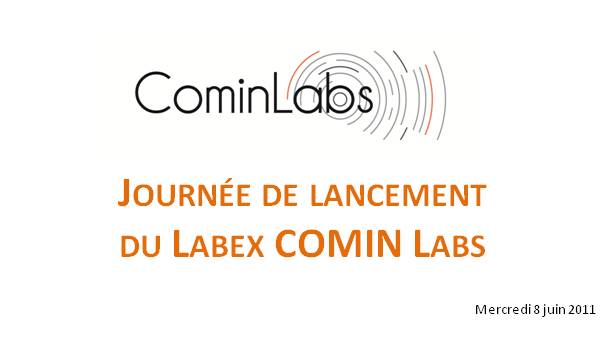 |

|
Inauguration du laboratoire d'excellence COMIN LABS
Centre Inria Rennes - Bretagne Atlantique - 8 juin 2011 |
L'ouverture |
|
|
Le 8 juin 2011, dans le cadre de la journée de lancement du Labex COMIN Labs, Patrick Bouthemy, directeur du centre Inria de Rennes a accueilli les invités par un mot de bienvenue.
Quatre représentants de l'Université et de la Région se sont ensuite succédés à la tribune, pour souligner l'importance économique de la création du Labex COMIN Labs.
- Guy Cathelineau, Président de l'UEB
- Patrick Chedmail, Président du pôle de recherche et d'enseignement supérieur de l'UNAM
- Bernard Pouliquen, Vice-président du conseil régional chargé de l'enseignement supérieur et de la recherche
- Michel Cadiot, Préfet de la région Bretagne
|
Présentation de COMIN Labs |
|
|
|
Albert Benveniste, directeur de recherche à l'INRIA (projet DistribCom) et responsable scientifique du LABEX, a présenté les grandes composantes de COMIN Labs.
|
|
|
| John Barras, professeur à l'Université du Maryland, a présenté une expérience du même type, menée aux Etats-Unis, sous le nom "The institute for systems research". |
Les enjeux socio-économiques de COMIN Labs |
|
|
Lors de cette table ronde, Albert Benveniste, directeur de recherche Inria,
Ramesh Pyndia, responsable département Signal & Communications, à Telecom Bretagne, Patrick Gros, chercheur Inria et responsable de l'équipe-projet TEXMEX, Lotfi Senhadji, du laboratoire Traitement du signal et de l'image, à l'INSERM, Université de Rennes 1, Laurent Manach, directeur du pôle EMC2 et coordinateur du projet IRT Jules Verne, Claude Daloz, France-Télécom Lannion, et John Barras, professeur à l'Université du Maryland, ont échangé leurs points de vue sur l'initiative COMIN Labs, en insistant sur l'impact socio-économique de cette structure.
|
Keynote Speech, by John Baras
(University of Maryland & Institute for Systems Research)
Challenges and Opportunities for Future Broadband Networks: From Physical to Services to Social |
|
|
Abstract
Broadband Communication Infrastructures are expanding rapidly and are becoming ubiquitous. They are affecting every aspect of life and work. We describe major challenges and opportunities in this critical area, from an integrated systems perspective. Hardware and physical layer advances will make possible new programmable types of networks and services.
In the wireless arena physical layer advances mitigate interference and will provide energy and bandwidth efficient and reliable communications. Services over the Future Internet and associated architectures are rapidly expanding and are increasingly interacting and integrated. Yet viewing these developments from a systems synthesis perspective lies in the future. A major challenge is to be able to synthesize communication and information networks so as to meet in a predictable manner specifications.
Key to the proposed research is the systematic development of components, component architectures and associated validation methodologies. Social networks over the web are also becoming ubiquitous and pose a unique set of challenges stemming primarily from the interactions of humans and technological networks. We describe new approaches in modeling and analysis of social networks and their dynamics including geometric and algebraic models, security and trust, privacy, reputation systems. Again the emphasis is on an integrated systems perspective and the need for appropriate model-based analytics.
We close with an integrated model of the communication, information and cognitive layers of future networks and a description of certain foundational problems it implies for networked systems.
|
John S. Baras, Lockheed Martin Chair in Systems Engineering
B.S. in Electrical Eng. from the Nat. Techn. Univ. of Athens, Greece, 1970; M.S. and Ph.D. in Applied Math. from Harvard Univ. 1971, 1973. Since 1973 with the Electrical and Computer Engineering Department, and the Applied Mathematics Faculty, at the University of Maryland College Park.
Since 2000 faculty member in the Fischell Department of Bioengineering. Founding Director of the Institute for Systems Research (ISR) from 1985 to 1991. Since 1991, has been the Director of the Maryland Center for Hybrid Networks (HYNET). Fellow of the IEEE and a Foreign Member of the Royal Swedish Academy of Engineering Sciences.
Received the 1980 George Axelby Prize from the IEEE Control Systems Society and the 2006 Leonard Abraham Prize from the IEEE Communications Society. Professor Baras' research interests include control, communication and computing systems.
|
Présentation des focus scientifiques de COMIN Labs
par
Claude Berrou, Anne-Marie Kermarrec, Jean-François Hélard, et Mario Südholt |
|
|
Neural coding: one of the big challenges of the century
Claude Berrou, professeur à Télécom Bretagne, évoque la manière dont les informations sont elles-mêmes codées par notre cerveau. |
|
|
The social Web
Anne-Marie Kermarrec, directrice de recherche à l'INRIA (projet ASAP), s'intéresse ici aux réseaux sociaux d'Internet. |
|
|
Energy and social efficiency in communication and information technology
Jean-François Hélard, professeur à l'INSA, nous montre comment l'augmentation du trafic d'informations sur l'Internet conduit à repenser la notion d'énergie dans la technologie de l'information. |
|
|
Security and privacy
Mario Südholt , professeur à l'école des Mines de Nantes, interroge la notion de sécurité dans les réseaux, problème à la fois sociétal, technique et économique. |
Clôture de la journée |
|
|
|
Christian Roux, vice-président du conseil scientifique de l'UEB, Claude Labit, vice-président du conseil scientifique de l'Université de Rennes 1, Jacques Girardeau, vice-président du conseil scientifique de l'Université de Nantes, Patrick Bouthemy, directeur du centre Inria de Rennes, et Albert Benveniste, responsable scientifique du Labex, ont conclu cette journée en invitant les acteurs du COMIN Labs à en développer les atouts. |
| |
| Contact web: Alain Crenn (REV) |
 retour vidéothèque retour vidéothèque |
| 2011- Inria-Rennes-Bretagne Atlantique |

 retour vidéothèque
retour vidéothèque